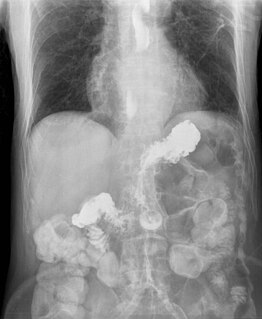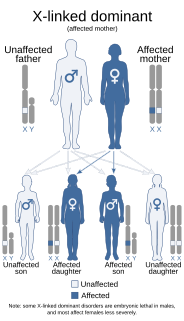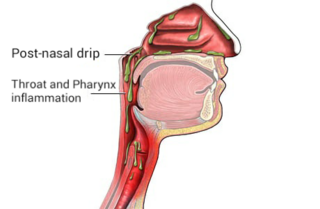Related Research Articles

Joubert syndrome is a rare autosomal recessive genetic disorder that affects the cerebellum, an area of the brain that controls balance and coordination.
Heartburn, also known as pyrosis, cardialgia or acid indigestion, is a burning sensation in the central chest or upper central abdomen. The discomfort often rises in the chest and may radiate to the neck, throat, or angle of the arm.

A cough is a sudden expulsion of air through the large breathing passages that can help clear them of fluids, irritants, foreign particles and microbes. As a protective reflex, coughing can be repetitive with the cough reflex following three phases: an inhalation, a forced exhalation against a closed glottis, and a violent release of air from the lungs following opening of the glottis, usually accompanied by a distinctive sound.

Gastroesophageal reflux disease (GERD), also known as acid reflux, is a long-term condition in which stomach contents rise up into the esophagus, resulting in either symptoms or complications. Symptoms include the taste of acid in the back of the mouth, heartburn, bad breath, chest pain, regurgitation, breathing problems, and wearing away of the teeth. Complications include esophagitis, esophageal stricture, and Barrett's esophagus.

Torticollis, also known as wry neck, is a dystonic condition defined by an abnormal, asymmetrical head or neck position, which may be due to a variety of causes. The term torticollis is derived from the Latin words tortus for twisted and collum for neck.

Dystonia is a neurological hyperkinetic movement disorder syndrome in which sustained or repetitive muscle contractions result in twisting and repetitive movements or abnormal fixed postures. The movements may resemble a tremor. Dystonia is often intensified or exacerbated by physical activity, and symptoms may progress into adjacent muscles.
Opsoclonus myoclonus syndrome (OMS), also known as opsoclonus-myoclonus-ataxia (OMA), is a rare neurological disorder of unknown cause which appears to be the result of an autoimmune process involving the nervous system. It is an extremely rare condition, affecting as few as 1 in 10,000,000 people per year. It affects 2 to 3% of children with neuroblastoma and has been reported to occur with celiac disease and diseases of neurologic and autonomic dysfunction.

Aicardi syndrome is a rare genetic malformation syndrome characterized by the partial or complete absence of a key structure in the brain called the corpus callosum, the presence of retinal abnormalities, and seizures in the form of infantile spasms.

Gastrointestinal diseases refer to diseases involving the gastrointestinal tract, namely the oesophagus, stomach, small intestine, large intestine and rectum, and the accessory organs of digestion, the liver, gallbladder, and pancreas.

Baby colic, also known as infantile colic, is defined as episodes of crying for more than three hours a day, for more than three days a week, for three weeks in an otherwise healthy child. Often crying occurs in the evening. It typically does not result in long-term problems. The crying can result in frustration of the parents, depression following delivery, excess visits to the doctor, and child abuse.

Post-nasal drip (PND) occurs when excessive mucus is produced by the nasal mucosa. The excess mucus accumulates in the back of the nose, and eventually in the throat once it drips down the back of the throat. It can be caused by rhinitis, sinusitis, gastroesophageal reflux disease, or by a disorder of swallowing. Other causes can be allergy, cold, flu, and side effects from medications.
Stiff-person syndrome (SPS), also known as stiff-man syndrome (SMS), is a rare neurologic disorder of unclear cause characterized by progressive rigidity and stiffness. The stiffness primarily affects the truncal muscles and is superimposed by spasms, resulting in postural deformities. Chronic pain, impaired mobility, and lumbar hyperlordosis are common symptoms.

Spasmodic torticollis is an extremely painful chronic neurological movement disorder causing the neck to involuntarily turn to the left, right, upwards, and/or downwards. The condition is also referred to as "cervical dystonia". Both agonist and antagonist muscles contract simultaneously during dystonic movement. Causes of the disorder are predominantly idiopathic. A small number of patients develop the disorder as a result of another disorder or disease. Most patients first experience symptoms midlife. The most common treatment for spasmodic torticollis is the use of botulinum toxin type A.
A functional symptom is a medical symptom, with no known physical cause. It arises from a problem in the ‘functioning’ of the nervous system, and not due to a structural or pathologically defined disease. Functional symptoms are increasingly viewed within a framework in which psychological, physiological and biological factors should be considered to be relevant.

Nutcracker esophagus, or hypertensive peristalsis, is a disorder of the movement of the esophagus characterized by contractions in the smooth muscle of the esophagus in a normal sequence but at an excessive amplitude or duration. Nutcracker esophagus is one of several motility disorders of the esophagus, including achalasia and diffuse esophageal spasm. It causes difficulty swallowing, or dysphagia, to both solid and liquid foods, and can cause significant chest pain; it may also be asymptomatic. Nutcracker esophagus can affect people of any age, but is more common in the sixth and seventh decades of life.

Laryngopharyngeal reflux (LPR) is the retrograde flow of gastric contents into the larynx, oropharynx and/or the nasopharynx. LPR causes respiratory symptoms such as cough and wheezing and is often associated with head and neck complaints such as dysphonia, globus pharyngis, and dysphagia. LPR may play a role in other diseases, such as sinusitis, otitis media, and rhinitis, and can be a comorbidity of asthma. While LPR is commonly used interchangeably with gastroesophageal reflux disease (GERD), it presents with a different pathophysiology.

Mitochondrial DNA depletion syndrome is any of a group of autosomal recessive disorders that cause a significant drop in mitochondrial DNA in affected tissues. Symptoms can be any combination of myopathic, hepatopathic, or encephalomyopathic. These syndromes affect tissue in the muscle, liver, or both the muscle and brain, respectively. The condition is typically fatal in infancy and early childhood, though some have survived to their teenage years with the myopathic variant and some have survived into adulthood with the SUCLA2 encephalomyopathic variant. There is currently no curative treatment for any form of MDDS, though some preliminary treatments have shown a reduction in symptoms.
A functional neurological disorder (FND) is a condition in which patients experience neurological symptoms such as weakness, movement disorders, sensory symptoms and blackouts. In the past, the brain of a patient with functional neurological symptom disorder was believed to be structurally normal, but functioning incorrectly. Patients with FND were marginalized for much of the 20th century, with limited clinical and neuroscientific interest. Converging evidence from several studies using different techniques and paradigms has now demonstrated distinctive brain activation patterns associated with functional deficits, unlike those seen in actors simulating similar deficits. New research has uncovered pathways in the brain’s white matter that may be altered in patients with functional neurological disorder (FND). The new findings advance current understanding of the mechanisms involved in this disease, and offer the possibility of identifying markers of the condition and patients’ prognosis.
Paul Harmer Sandifer was a British medical doctor. He is considered one of the early founders of paediatric neurology in Great Britain.
Oral manifestations of systematic disease are signs and symptoms of disease occurring elsewhere in the body detected in the oral cavity and oral secretions. High blood sugar can be detected by sampling saliva. Saliva sampling may be a non-invasive way to detect changes in the gut microbiome and changes in systemic disease. Another example is tertiary syphilis, where changes to teeth can occur. Syphilis infection can be associated with longitudinal furrows of the tongue.
References
- ↑ "Sandifer syndrome". Rarediseases.info.nih.gov. Retrieved 11 December 2014.
- 1 2 3 4 5 "Orphanet: Sandifer syndrome". Orpha.net. Retrieved 11 December 2014.
- 1 2 3 Theodoropoulos, D. S; Lockey, R. F; Boyce, H W. (1999). "Sandifer's syndrome and gastro- oesophageal reflux disease". Journal of Neurology, Neurosurgery & Psychiatry. 66 (6): 805–6. doi:10.1136/jnnp.66.6.805. PMC 1736393 . PMID 10400514.
- 1 2 3 4 5 6 Sandifer Syndrome at eMedicine
- ↑ Archived November 22, 2010, at the Wayback Machine
- ↑ Kinsbourne, M (1964). "Hiatus Hernia with Contortions of the Neck". Lancet. 1 (7342): 1058–61. doi:10.1016/s0140-6736(64)91264-4. PMID 14132602.
- ↑ Medow, Marvin; Bostwick, Howard; Berezin, Stuart; Bamji, Natasha (2015). "Treatment of Sandifer Syndrome with an Amino-Acid–Based Formula". AJP Reports. 5 (1): e51–2. doi:10.1055/s-0035-1545672. PMC 4502620 . PMID 26199799.
- ↑ Lehwald, N.; Krausch, M.; Franke, C.; Assmann, B.; Adam, R.; Knoefel, W. (2007). "Sandifer Syndrome - A Multidisciplinary Diagnostic and Therapeutic Challenge". European Journal of Pediatric Surgery. 17 (3): 203–6. doi:10.1055/s-2007-965145. PMID 17638161.
- ↑ Deskin, Ronald W. (1995). "Sandifer syndrome: A cause of torticollis in infancy". International Journal of Pediatric Otorhinolaryngology. 32 (2): 183–5. doi:10.1016/0165-5876(95)01130-4. PMID 7657473.
- ↑ Nalbantoglu, B; Metin, D. M.; Nalbantoglu, A (2013). "Sandifer's Syndrome: A Misdiagnosed and Mysterious Disorder". Iranian Journal of Pediatrics. 23 (6): 715–6. PMC 4025139 . PMID 24910760.